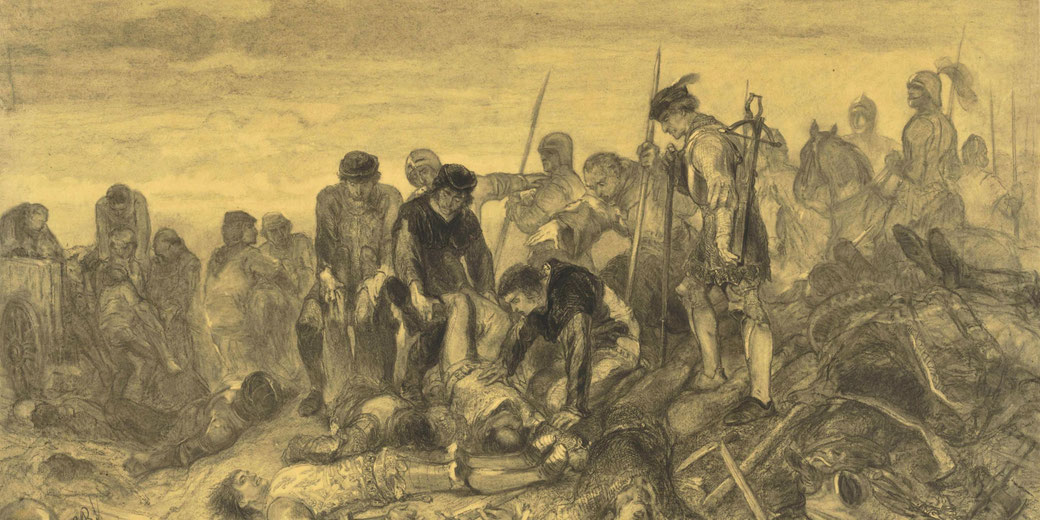How the Battle of Bosworth changed England forever

The Battle of Bosworth Field, fought on August 22, 1485, was a turning point in English history, a clash that not only ended the life of a king but also brought a definitive conclusion to the Wars of the Roses.
This series of civil wars had torn England apart for over three decades, pitting the House of York against the House of Lancaster in a bloody struggle for the throne.
The battle's outcome would usher in a new era, giving birth to the Tudor dynasty and setting the stage for a period of remarkable transformation in English governance, culture, and global influence.
Wars of the Roses: The civil war tearing England apart
The Wars of the Roses, a series of conflicts that spanned from 1455 to 1487, set the stage for the Battle of Bosworth.
These wars were a manifestation of deep-rooted tensions within the English nobility, primarily between the rival houses of Lancaster and York.
Both claimed descent from the Plantagenet line and, thus, had legitimate claims to the throne.
The conflict was exacerbated by weak leadership, economic hardship, and internal divisions, creating a volatile mix that would consume England for over three decades.
The wars saw multiple shifts in power, with the throne changing hands between Lancastrian and Yorkist rulers, each reign marked by its own set of triumphs and tragedies.
Amidst this backdrop of shifting allegiances and constant warfare, Richard III ascended to the throne in 1483 under controversial circumstances.
His two young nephews, the sons of his deceased brother Edward IV, were declared illegitimate, and they subsequently disappeared under mysterious circumstances, leading many to suspect Richard of their murder.
Richard III's rule was fraught with challenges, including rebellions and a tarnished reputation.
On the other side of the channel, Henry Tudor, a relatively unknown figure with a tenuous claim to the throne through his mother's Lancastrian lineage, was plotting to unseat Richard.
Exiled in France, Henry garnered support from discontented English nobles and French backers, setting the stage for his return to England and a confrontation with Richard III.
Henry Tudor's landing in Wales in 1485 was a gamble, but it was one that began to pay off as he marched through the country gathering support.
His army was a patchwork of French mercenaries, Scottish allies, and English rebels, united more by their opposition to Richard than by any deep loyalty to the Lancastrian cause.
As Henry moved closer to a confrontation with Richard, the stakes could not have been higher.
The Yorkist king, aware of the threat Henry posed, also began to muster his forces, which included seasoned veterans of the Wars of the Roses.
Richard was confident, perhaps overly so, buoyed by the belief that his superior numbers and battle-hardened troops would carry the day.
The two different armies
Richard's forces were a formidable assembly, boasting around 10,000 to 15,000 men, according to various historical estimates.
His army was a mix of seasoned veterans from earlier conflicts in the Wars of the Roses, as well as knights and nobles loyal to the Yorkist cause.
Richard had at his disposal a range of military resources, including cavalry, infantry armed with longbows and bills, and even some artillery.
The Yorkist army was not just larger but also more experienced, a fact that gave Richard considerable confidence as he surveyed the battlefield from his vantage point on Ambion Hill.
Across the field, Henry Tudor's army was significantly smaller, numbering perhaps between 5,000 and 8,000 men.
What his force lacked in size and experience, it made up for in determination and the element of surprise.
Henry's troops were a diverse lot, comprising Lancastrian loyalists who had been with him in exile, French mercenaries provided by his foreign backers, and English rebels who had joined him during his march from Wales.
The army also included a contingent of Welsh soldiers, drawn to Henry partly because of his Welsh ancestry through his father, Edmund Tudor.
Despite the disparate origins of his troops, Henry managed to forge a sense of unity, aided by the tactical acumen of experienced commanders like John de Vere, the 13th Earl of Oxford.
The wild card in this military tableau was the force commanded by the Stanley brothers, Thomas and William.
Their troops, estimated to number around 6,000, were positioned strategically, and their allegiance was the subject of much speculation.
Richard III had reason to be wary; he had even taken Lord Stanley's son as a hostage to ensure the family's loyalty.
However, the Stanleys were also related to Henry Tudor through marriage, as Thomas Stanley was married to Henry's mother, Margaret Beaufort.
This familial connection cast a shadow of uncertainty over their ultimate loyalty, making them a crucial factor that could tip the scales in favor of either contender.

How the battle unfolded
The morning mist that shrouded Bosworth Field began to lift, revealing two armies poised for a battle that would reshape the destiny of England.
Richard III, atop his vantage point on Ambion Hill, gave the order, and his Yorkist troops advanced, their armor glinting in the morning sun.
Across the field, Henry Tudor, flanked by his commanders, watched as the Earl of Oxford led the Lancastrian forces forward.
The initial skirmishes were fierce but inconclusive, a testing of mettle and resolve as both sides sought to gauge the strength and tactics of their opponents.
Arrows flew, artillery roared, and the clamor of steel on steel filled the air, a cacophony that heralded the unfolding of a historic drama.
As the battle raged, Richard III saw an opportunity that he believed could bring a swift and decisive victory.
He spotted Henry Tudor, relatively unprotected, and made a bold decision: he would lead a cavalry charge aimed at killing Henry and ending the battle in a single stroke.
With a cry, Richard led his knights in a thunderous charge across the field, cutting down anyone who stood in his way.
He came perilously close to his target, but just as victory seemed within his grasp, the unexpected happened.
The Stanley forces, who had remained conspicuously neutral, sprang into action.
Led by Sir William Stanley, they joined the fray on Henry Tudor's side, turning the tide of the battle in a moment that would become the stuff of legend.
The intervention of the Stanley forces was a devastating blow to Richard III. Outnumbered and surrounded, he fought on, refusing to retreat.
His cries of "Treason! Treason!" echoed on the battlefield, a poignant testament to the betrayal he felt.
In the end, Richard III was cut down, his body left on the field as a grim marker of the end of the Yorkist reign.
"The king is dead," the cry went up, and with it, the fate of the battle was sealed.
The aftermath and its consequences
Henry Tudor, now the uncontested victor, was hastily crowned on the battlefield with Richard's circlet, which had been found in a thorn bush.
The dust had barely settled on Bosworth Field when the implications of what had transpired began to sink in.
Richard III, the last Plantagenet king, lay dead, his reign brought to an abrupt and violent end.
Henry VII wasted no time in legitimizing his reign. He dated his reign from the day before the Battle of Bosworth, effectively branding all who had fought for Richard as traitors.
This allowed him to confiscate their lands and wealth, thereby strengthening his own financial position.
But Henry was also keenly aware that his reign needed a sense of continuity and reconciliation, not just for the vanquished but for a nation weary of decades of civil war.
To this end, he married Elizabeth of York, daughter of Edward IV and sister to the missing Princes in the Tower.
This union symbolically brought together the warring houses of Lancaster and York, and the emblem of the Tudor Rose—a fusion of the white rose of York and the red rose of Lancaster—became a powerful symbol of this newfound unity.
The coronation of Henry VII was a carefully orchestrated affair, designed to project an image of stability and divine sanction.
As he was crowned in Westminster Abbey, the message was clear: the Wars of the Roses had come to an end, and a new era had begun.
Henry set about establishing a strong centralized monarchy, introducing key financial and legal reforms that laid the groundwork for the Tudor dynasty.
His reign would see not only the end of a domestic conflict but also the beginning of England's emergence as a significant power on the European stage.
Why was this battle so important?
The end of the Wars of the Roses and the rise of the Tudor dynasty marked a turning point in English history, ushering in an era of transformation that would have lasting implications.
Henry VII's reign laid the groundwork for a more centralized form of governance, introducing financial and legal reforms that strengthened the monarchy and curtailed the power of the nobility.
These changes were instrumental in stabilizing a country that had been torn apart by decades of civil war, setting the stage for a period of relative peace and prosperity.
The Tudor dynasty itself would become one of the most iconic in English history, producing figures like Henry VIII and Elizabeth I, who left significant marks on the country's religious, political, and cultural landscape.
The establishment of the Church of England under Henry VIII and the subsequent Elizabethan era's contributions to literature, exploration, and the arts can all trace their roots back to the pivotal moment when Henry Tudor defeated Richard III on Bosworth Field.
The battle also had a profound impact on the English monarchy's perception, shifting it from a prize to be won in battle to an institution with divine and legal authority.
This change in perception helped to lay the foundations for the constitutional monarchy that would later emerge, shaping the political structure of modern-day Britain.
What do you need help with?
Download ready-to-use digital learning resources
Copyright © History Skills 2014-2025.
Contact via email
With the exception of links to external sites, some historical sources and extracts from specific publications, all content on this website is copyrighted by History Skills. This content may not be copied, republished or redistributed without written permission from the website creator. Please use the Contact page to obtain relevant permission.





